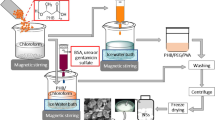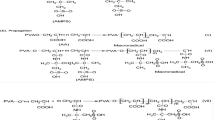Abstract
Chemical modification of native biopolymers may introduce in them some new surface functionalities for the controlled loading/release of foreign species of biomedical significance such as drugs, proteins, cellular metabolites, etc. The present study undertakes the preparation of poly(caprolactone) mediated poly(hydroxybutyrate) (PHB) multicomponent films with poly(lactic acid) as a plasticizer. The prepared films were surface chemical functionalized with amino groups using the ethylenediamine in aqueous or organic media; the process is called aminolysis. The aminolyzed multicomponent films contained active hydrophilic groups offering opportunities for the immobilization of bovine serum albumin (BSA, as a model protein). The extent of aminolysis was tracked using ninhydrin assay, and the prepared films were further characterized using contact angle measurement, Fourier transform infrared spectroscopy, scanning electron microscopy, thermal analysis, x-ray diffraction, and Raman spectroscopy. The results demonstrated the successful formation and aminolysis of PHB-based multicomponent films with desirable amino-hydrophilicity for controlled impregnation and release of BSA.














Similar content being viewed by others
References
Guo W, Yanf Z, Qin X et al (2021) Fabrication and characterization of the core-shell structure of poly(3-hydroxybutyrate-4-hydroxybutyrate) nanofiber scaffolds. Biomed Res Int 2021:8868431
Zihayat B, Shakibaie M, Sabouri-Shahrbabak S et al (2019) Medium optimization for polyhydroxyalkanoate production by Pseudomonas pseudoalcaligenes strain Te using D-optimal design. Biocat Agric Biotechnol 18:101001.
Raza ZA, Khalil S, Abid S (2020) Recent progress in development and chemical modification of poly(hydroxybutyrate) based blends for potential medical applications. Int J Biol Macromol 160:77–100
Manikandan N, Pakshirajan K, Pugazhenthi G (2020) Preparation and characterization of environmentally safe and highly biodegradable microbial polyhydroxybutyrate (PHB) based graphene nanocomposites for potential food packaging applications. Int J Biol Macromol 154:866–877
Garcia D, Ferri JM, Boronat T et al (2016) Processing and characterization of binary poly(hydroxybutyrate) (PHB) and poly(caprolactone) (PCL) blends with improved impact properties. Polym Bull 73:3333–3350
Bonartsev A, Zharkova I, Yakovlev S et al (2016) 3D-scaffolds from poly(3-hydroxybutyrate) poly(ethylene glycol) copolymer for tissue engineering. J Biomater Tissue Eng 6:42–52
Balla E, Daniilidis V, Karlioti G et al (2021) Poly(lactic acid): a versatile biobased polymer for the future with multifunctional properties—from monomer synthesis, polymerization techniques and molecular weight increase to PLA applications. Polym 13:1822
Xue J, He M, Liu H et al (2014) Drug loaded homogeneous electrospun PCL/gelatin hybrid nanofiber structures for anti-infective tissue regeneration membranes. Biomater 35:9395–9405
Ansari Z, Kalantar M, Kharaziha M, et al (2020) Polycaprolactone/fluoride substituted-hydroxyapatite (PCL/FHA) nanocomposite coatings prepared by in-situ sol-gel process for dental implant applications. Prog Org Coat 147:105873.
Siddiqui N, Asawa S, Birru B et al (2018) PCL-based composite scaffold matrices for tissue engineering applications. Mol Biotechnol 60:506–532
Plavec R, Hlavacikova S, Omanikova L et al (2020) Recycling possibilities of bioplastics based on PLA/PHB blends. Polym Test 92:106880.
Yeo JCC, Muiruri JK, Tan BH et al (2018) Biodegradable PHB-rubber copolymer toughened PLA green composites with ultrahigh extensibility. ACS Sustain Chem Eng 6:15517–15527
Wua L, Shresthab P, Iapichinob M (2021) Characterization method for calculating diffusion coefficient of drug from polylactic acid (PLA) microneedles into the skin. J Drug Deliv Sci Technol 61:102192.
Gardner D, Aydemir D (2020) Biopolymer blends of polyhydroxybutyrate and polylactic acid reinforced with cellulose nanofibrils. Carbohydr Polym 250:116867.
Yoon YI, Moon HS, Lyoo WS et al (2008) Superhydrophobicity of PHBV fibrous surface with bead-on-string structure. J Colloid Interface Sci 320:91–95
Bonartsev AP, Voinova VV, Kuznetsova ES et al (2018) BSA adsorption on porous scaffolds prepared from bioPEGylated poly(3-hydroxybutyrate). Appl Biochem Microbiol 54:379–386
Vigneswari S, Murugaiyah V, Kaur G et al (2016) Biomacromolecule immobilization: grafting of fish-scale collagen peptides onto aminolyzed P(3HB-co-4HB) scaffolds as a potential wound dressing. Biomed Mater 11:055009.
Gittens RA, Scheideler L, Rupp F et al (2014) A review on the wettability of dental implant surfaces II: biological and clinical aspects. Acta Biomater 10:2907–2918
Raza ZA, Noor S, Majeed MI (2021) PEGylation of poly(hydroxybutyrate) into multicomponent nanostructures and loading thereon with bioactive molecules for potential biomedical applications. J Polym Res 28:118
Zhu Y, Gao C, Liu X et al (2002) Surface modification of polycaprolactone membrane via aminolysis and biomacromolecule immobilization for promoting cytocompatibility of human endothelial cells. Biomacromol 3:1312–1319
Rodríguez-Alba E, Dionisio N, Calixto M et al (2020) Surface modification of polyethylenterephthalate film with primary amines using gamma radiation and aminolysis reaction for cell adhesion studies. Radiat Phys Chem 176:109070.
Chen Y, Hung S-T, Chou E et al (2018) Review of polyhydroxyalkanoates materials and other biopolymers for medical applications. Mini Rev Org Chem 15:105–121
Raza ZA, Anwar F, Hussain I et al (2019) Fabrication of PLA incorporated chitosan nanoparticles to create enhanced functional properties of cotton fabric. Pigment Resin Technol 48:169–177
García JM, Garrido I, López L et al (2013) The surface modification of poly(3-hydroxybutyrate-co-3-hydroxyhexanoate) copolymers to improve the attachment of urothelial cells. Mater Sci Eng C 33:362–369
Zhu Y, Mao Z, Shi H et al (2012) In-depth study on aminolysis of poly(ɛ-caprolactone): Back to the fundamentals. Sci China Chem 55:2419–2427
Manah NSA, Sulaiman L, NLSM Azman et al (2019) Colour analysis of organic synthetic dye coating paint films consisting 4-hydroxycoumarin derivatives after exposed to UV-A. Mater Res Express 6:076418.
Costanzo GD, Ribba L, Goyanes S et al (2014) Enhancement of the optical response in a biodegradable polymer/azo-dye film by the addition of carbon nanotubes. J Phys D 47:135103.
Bakare RA, Bhan C, Raghavan D (2014) Synthesis and characterization of collagen grafted poly(hydroxybutyrate-valerate) (PHBV) scaffold for loading of bovine serum albumin capped silver (Ag/BSA) nanoparticles in the potential use of tissue engineering application. Biomacromol 15:423–435
Gurler EB, Ergul NM, Ozbek B, Ekren N, Oktar FN, Haskoylu ME, Korkut V (2019) Encapsulated melatonin in polycaprolactone (PCL) microparticles as a promising graft material. Mater Sci Eng, C 100:798–808
Abdelwahab MA, Ahmed A, El-Said KS et al (2019) Evaluation of antibacterial and anticancer properties of poly(3-hydroxybutyrate) functionalized with different amino compounds. Int J Biol Macromol 122:793–805
Gardiner DJ (1989) Practical Raman spectroscopy. Springer-Verlag, Germany
Lopusiewicz L, Jędra F, Mizielińska M (2018) New poly(lactic acid) active packaging composite films incorporated with fungal melanin. Polymers (Basel) 10:386
Jiang X, Luo Y, Tian X et al (2010) Chemical structure of poly(lactic acid). In: Auras R, Lim L-T, Selke SEM et al (eds) Poly(lactic acid): synthesis, structures, properties, processing, and applications. Wiley, New York, pp 67–82.
Jeong H, Rho J, Shin J-Y, Lee DY, Hwang T, Kim KJ (2018) Mechanical properties and cytotoxicity of PLA/PCL films. Biomed Eng Lett 8(3):267–272
Arrieta MP, López J, López D et al (2015) Development of flexible materials based on plasticized electrospun PLA-PHB blends: Structural, thermal, mechanical and disintegration properties. Eur Polym J 73:433–446
Wang J, Wu Y, Cao Y et al (2020) Influence of surface roughness on contact angle hysteresis and spreading work. Colloid Polym Sci 298:1107–1112
Surmenev R, Chernozem R, Syromotina D et al (2019) Low-temperature argon and ammonia plasma treatment of poly-3-hydroxybutyrate films: Surface topography and chemistry changes affect fibroblast cells in vitro. Eur Polym J 112:137–145
Kreader CA (1996) Relief of amplification inhibition in PCR with bovine serum albumin or T4 gene 32 proteins. Appl Environ Microbiol 62(3):1102–1106
Zhang L, Xiong C, Deng X (1996) Miscibility, crystallization and morphology of poly(β-hydroxybutyrate)/poly(d, l-lactide) blends. Polym 37:235–241
Abdelwahab MA, Flynn A, Chiou BS et al (2012) Thermal, mechanical and morphological characterization of plasticized PLA-PHB blends. Polym Degrad Stab 97:1822–1828
Hinuber C, Haussler L, Vogel R et al (2011) Hollow fibers made from a poly(3-hydroxybutyrate)/poly-e-caprolactone blend. Polym Lett 5:643–652
Li F, Tian F, Liu CJ, Zhao YL (2009) Preparation and characterization of improved microspheres containing bovine serum albumin. J Appl Polym Sci 114:818–825
Cao K, Liu Y, Olkhov A, Siracusa V, Iordanskii A (2018) PLLAPHB fiber membranes obtained by solvent-free electrospinning for short-time drug delivery. Drug Deliv Transl Res 8:291–302
Raza ZA, Khatoon R, Banat MI (2021) Altering the hydrophobic/hydrophilic nature of bioplastic surfaces for biomedical applications. In: Kuddus M, Roohi (eds) Bioplastics for sustainable development. Springer, Singapore, pp 431–466
Acknowledgements
The authors acknowledge the financial support by Higher Education Commission, Islamabad in pursuing this study.
Author information
Authors and Affiliations
Corresponding author
Additional information
Publisher's Note
Springer Nature remains neutral with regard to jurisdictional claims in published maps and institutional affiliations.
Rights and permissions
About this article
Cite this article
Raza, Z.A., Khalil, S., Majeed, M.I. et al. Aminolysis of poly(hydroxybutyrate)-based multicomponent films for the impregnation of bovine serum albumin. Polym. Bull. 80, 2019–2043 (2023). https://doi.org/10.1007/s00289-022-04165-7
Received:
Revised:
Accepted:
Published:
Issue Date:
DOI: https://doi.org/10.1007/s00289-022-04165-7




